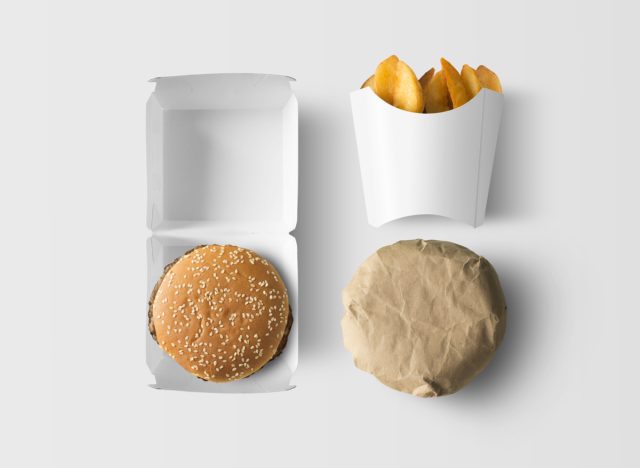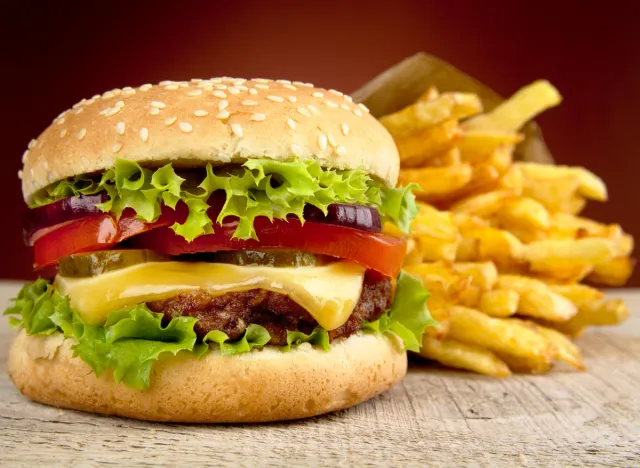5 Truths About the Fast-Food Industry That Will Make You Lose Your Appetite

There may be no such thing as a free lunch, but there are plenty of cheap lunches. Fast food is everywhere. Whether you’re in the heart of a city or driving along a remote lonely highway, one thing remains the same: The golden arches are always nearby.
For better or worse, fast food is an undeniable component of Western culture—and diets. Per the Centers for Disease Control and Prevention (CDC), over 36% of U.S. adults ate fast food on any given day between 2013 and 2016. Fast forward a few years, and fast food actually became even more popular during the COVID-19 pandemic. A drive-thru window is that much more enticing when indoor dining is a potential health risk.
The pandemic effect shows no signs of slowing either. If anything, the demand for fast food in the U.S. continues to grow. The first quarter of 2021 saw fast-food restaurants enjoy a 33.06% increase in customer traffic.
It’s easy to explain why fast food is so popular. It’s convenient, affordable, and in most cases, tasty too. It also largely transcends income brackets. A study published in the journal of Economics & Human Biology, which analyzed eating habits among 8,000 Americans of various income levels, found negligible differences in fast food consumption. Across all income levels, 79% of subjects ate fast food at least once per week.
Of course, there’s also a dark side to fast food. The detrimental health effects of eating this highly processed stuff on a regular basis are well-documented. Taste and convenience today set the stage for obesity, diabetes, and heart disease tomorrow.
Besides the obvious nutritional concerns, fast food has also been linked to a number of surprising and unexpected negative side effects. For example, a study published in Psychological Science reports a connection between exposure to fast food and impatience. Another research project published in Public Health Nutrition found that people who eat fast food are 51% more likely to feel depressed.
Fast food may even drain your brain. One study released in Clinical Pediatrics found that eating more fast food was associated with lower academic grades in middle school.
Starting to rethink today’s lunch plans? We’re just scratching the surface. Keep reading to learn five unappetizing truths about the fast-food industry.
Fast food wrappers are full of ‘forever chemicals’

Research released this spring by Consumer Reports discovered high levels of chemicals called PFAs (per- and polyfluoroalkyl substances) in the wrappers and packaging used by several national fast-food chains.
PFAs are also known as “forever chemicals,” because they don’t break down in the environment, instead persisting for thousands of years. These chemicals are known to build up in animals, the environment, and even people.
“We know that these substances migrate into food you eat,” Justin Boucher, an environmental engineer at the Food Packaging Forum, a nonprofit research organization based in Switzerland, told Consumer Reports. “It’s clear, direct exposure.”
The health effects of PFA exposure still aren’t totally clear, but the CDC already calls PFAs a “public health concern.” Various research projects have linked PFAs to fertility problems, developmental issues in children, increased cancer risk, and weakened immune responses.
In the fast-food world, PFAs are used to stop grease and water from soaking through wrappers and packaging. After testing 118 food packaging products sold in the New York tri-state area in 2021, researchers report some of the top PFA offenders were Nathan’s Famous bag for sides, McDonald’s fry bag, Chick-fil-A’s sandwich wrapper, Taco Bell’s chip bag, and Arby’s cookie bag.
Fast food keeps getting unhealthier

Over the years, various fast-food chains have introduced healthier menu options like salads and fruits. One might assume that means fast-food menus are healthier today than decades ago, but that doesn’t appear to be the case. As time goes on, fast food is becoming more and more unhealthy.
Scientists at Boston University analyzed the menus of ten popular fast food chains in 1986, 1991, and 2016. They discovered that most fast-food entrées, sides, and desserts contain far more calories and sodium nowadays than they did in the 1980s or 1990s. Portion sizes have increased as well. There may be more menu options, but overall nutritional quality of fast food continues to decline.
“Our study offers some insights on how fast food may be helping to fuel the continuing problem of obesity and related chronic conditions in the United States. Despite the vast number of choices offered at fast-food restaurants, some of which are healthier than others, the calories, portion sizes, and sodium content overall have worsened (increased) over time and remain high,” says lead investigator Megan A. McCrory.
Even more chemicals

PFAs aren’t the only chemicals you should worry about when it comes to fast food. We’ve already covered “forever chemicals,” now let’s move on to “everywhere chemicals.”
Phthalates are a group of man-made chemicals used to make plastics more durable. They’re called “everywhere chemicals” because they’re found in a wide array of products such as shampoos, soaps, vinyl flooring, and toys. Importantly, phthalates are also used in food packaging and food processing equipment.
Similar to PFAs, they’ve been linked to a number of health issues such as autism, cancer, and neurodevelopmental problems.
What does this have to do with fast food? Research conducted at George Washington University in 2021 and published in the Journal of Exposure Science & Environmental Epidemiology found that phthalates and other plasticizers are widespread in fast-food dishes.
Some phthalates have already been banned in certain products, so manufacturers use “replacement plasticizers” instead. The only problem with that is these replacement chemicals are woefully understudied. We don’t know what effect (if any) they’re having on people upon exposure.
“We found phthalates and other plasticizers are widespread in prepared foods available at U.S. fast-food chains, a finding that means many consumers are getting a side of potentially unhealthy chemicals along with their meal,” said lead study author Lariah Edwards. “Stronger regulations are needed to help keep these harmful chemicals out of the food supply.”
The study authors analyzed 64 menu items (fries, pizza, burritos, etc.) from six different fast-food restaurants. The specific names of the brands weren’t included, but researchers note their work included common burger chains, pizza chains, and Tex-Mex chains. All in all, 81% of examined fast-food samples contained a phthalate called DnBP, while another 70% contained the phthalate DEHP. Meanwhile, 86% of studied foods contained the replacement plasticizer called DEHT.
Why is fast food covered in phthalates? Researchers explain the chemicals often make their way from food-handling gloves, conveyor belts, and tubing into fast foods.
Fast food appearances are deceiving

Fast-food commercials make burgers, wraps, and sides look absolutely mouth-watering. No fast-food burger on TV is soggy or sloppedly put together. The reality of fast food, however, is often disappointing.
In fact, the more you peel back the curtain on the world of fast food, it becomes clearer and clearer that things are rarely as they seem. For instance, did you know that Ireland ruled Subway’s bread can’t legally be called “bread” due to excessive sugar levels? It sounds like a fake headline, but it’s true. The overall sugar content of Subway’s bread is 10% of the weight of the flour.
Another example: The vast majority of “grill marks” seen on fast-food burgers and sandwiches are fakes, burnt on by a rotary brander, not an actual grill.
That being said, let’s give credit where credit is due. Burger King is one of the few fast-food brands that isn’t lying when they say they flame-grill their beef (but it may be lying about the size of its Whoppers). Chick-fil-A menu items also feature real grill marks.
Fast food targets children

A recent poll from the University of Michigan reports one in five U.S. parents admit their kids are eating more fast food these days in comparison to the pre-pandemic days. But children had been begging mom and dad to stop at the drive-thru long before 2020.
Historically, the fast-food industry has always targeted children via the use of toys, colorful advertisements, and collaborations with popular media properties. And that’s not even mentioning the children’s play areas built into fast-food locations. It isn’t a stretch to say the entire industry is catered toward kids.
One study published in PLOS ONE concludes fast-food ads aimed at children emphasize prizes and movie tie-ins far more than food.
Another report, also published in PLOS ONE, even found that children’s fast-food advertising often contradicts its own self-regulatory guidelines laid out by the Better Business Bureau. Food marketing geared to kids is supposed to emphasize healthy options, but after watching a few McDonald’s and Burger King commercials intended for kids, a group of children could barely remember anything about the ads except the toys. The young participants only recalled healthy foods shown in the ads, such as fruit and milk, less than 10% of the time.
Recent research published in BMJ Nutrition Prevention & Health also reveals that McDonald’s appears to be purposely targeting and focusing on children living in low-income countries. Scientists found that the chain’s Instagram advertising campaigns in lower-income nations feature more child-friendly posts, giveaways, and price promotions. Conversely, lower-income countries also get fewer Instagram marketing posts depicting healthy habits.
“As social media use grows, fast food companies’ social media ads may have unprecedented effects on dietary options, especially in lower-income countries,” the study concludes. “By targeting certain subsets through child-targeted ads and price promotions, McDonald’s social media ads may exacerbate healthcare issues in the most vulnerable countries in the world.”









